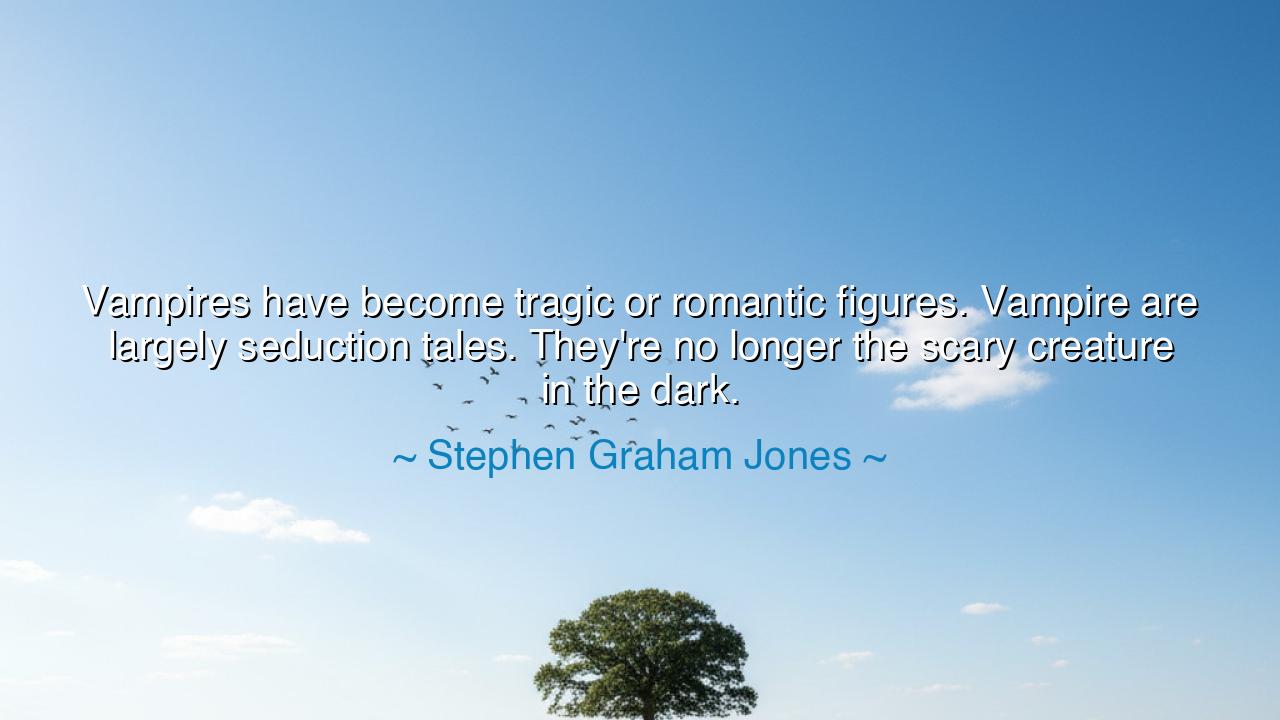
Vampires have become tragic or romantic figures. Vampire are
Vampires have become tragic or romantic figures. Vampire are largely seduction tales. They're no longer the scary creature in the dark.






Hear the words of Stephen Graham Jones, who observed with keen vision: “Vampires have become tragic or romantic figures. Vampires are largely seduction tales. They’re no longer the scary creature in the dark.” In these words lies the transformation of myth across the centuries, a reminder that creatures born from fear may, in time, be reborn as symbols of longing, desire, and sorrow. What was once a monster of nightmare has become an emblem of romance, a mirror of human hunger and fragility.
In their origin, the vampires of folklore were not seductive but terrifying. They were creatures of the grave, bloated and foul, who brought pestilence, drained life, and haunted the villages of Eastern Europe. These beings embodied fear of death and disease, reminders of mortality stalking through the night. They were indeed “the scary creature in the dark,” the very embodiment of the unknown, of all that lurks beyond the circle of firelight. Yet as time passed, the vampire was transformed, not by peasants’ tales, but by poets and novelists, who dressed the beast in beauty and sorrow.
The change began with John Polidori’s “The Vampyre” in 1819, where the monster was given aristocratic allure. Later, Bram Stoker’s “Dracula” carried both terror and seduction, painting the vampire as a figure who lured rather than only slaughtered. And in the centuries that followed, from Anne Rice’s “Interview with the Vampire” to the popular sagas of the modern day, the vampire ceased to be only a monster—it became tragic, cursed to eternal life without peace, and romantic, entangled with desire, forbidden love, and the aching weight of immortality. Thus the vampire became a reflection not of disease, but of longing.
Jones is right to name them now as seduction tales. For what is a vampire story today but the promise of forbidden passion? The vampire whispers of danger wrapped in beauty, of desire that defies morality, of intimacy deeper than blood itself. Where once the vampire frightened, now it entices. Where once it prowled as terror, now it glimmers as a dark lover. Humanity, which once needed monsters to embody its fear of death, now uses them to explore its yearning for love, immortality, and transcendence.
History itself shows us this shifting of symbols. Consider how the Greek sirens, once terrible creatures devouring sailors, were reshaped into enchanting maidens whose voices lured men to their doom. Or how the fallen angels of Christian lore, once symbols of rebellion and terror, became in poetry figures of tragic grandeur, embodying pride and longing. So too the vampire, from filthy corpse to romantic immortal, has followed this ancient pattern: monsters are always mirrors, changing as humanity changes, reflecting back not what is outside us, but what lies within.
The deeper meaning is clear: when Jones says vampires are “no longer the scary creature in the dark,” he is teaching us that the stories of a people evolve with their needs. Once, we needed to fear death and disease, so our tales made vampires grotesque. Now, we struggle more with loneliness, alienation, forbidden desire—so our vampires reflect those pains instead, becoming lovers, outsiders, tragic figures who suffer as we do. The monster remains, but its mask shifts with the heart of humanity.
The lesson, therefore, is this: do not think monsters exist only to frighten. They exist to reveal what we secretly fear, what we secretly long for. Learn to look at the monsters of your time—whether they appear in films, in myths, or in your own heart—and ask: What do they mirror? What do they teach about who we are now? For in the monster’s shadow you will find the truth of your age.
Thus, Stephen Graham Jones’ words become timeless counsel: the vampire has changed, from terror to romance, from beast to symbol of desire. And so it is with all stories. They do not die—they transform, just as humanity transforms. And in their transformation, they whisper back to us what we dare not say aloud: that we fear, that we love, that we long, and that even in the dark, we search for connection.






AAdministratorAdministrator
Welcome, honored guests. Please leave a comment, we will respond soon